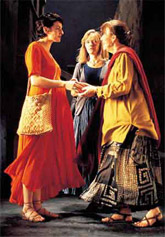| |
Bill Viola, born in New York City in 1951, has used video to make works of art since 1970, soon after the portable video camera became available. From his earliest videotapes, the work has explored states of consciousness, most often conveyed by images of the ordinary world.
Viola carefully chooses and edits images he has recorded with his camera in order to draw out particular meanings, avoiding the overt use of special effects and computer graphics. He intends his work to be a means of transformation for himself, and for spectators, through a deepened experience of the world and the self. Since the 1980s Viola has been best known for museum installations—galleries turned into media environments with video projections, sound and, at times, physical objects (he has also been a musician and audio/video engineer).
 |
|
|
|
| |
 The Greeting
The Greeting, 1995 |
|
|
In 1995 Viola was the U.S. representative to the Venice Biennale, where his exhibition included an installation called The Greeting. Based on a painting by the 16th-century painter Pontormo, it used actors and constructed sets and opened up new expressive possibilities for Viola. In 1998 he was a visiting scholar at the Getty Research Institute and there intensified his study of the history of art. In 2000 he began to make The Passions, works exploring human emotions that are inspired by earlier devotional paintings.
Viola lives and works in Long Beach, California. He was attracted to the city in 1981 by
the prominence given to video art at the Long Beach Museum of Art. The photographer
and arts administrator Kira Perov is his wife, collaborator, and executive producer.
 |
 |
|
|